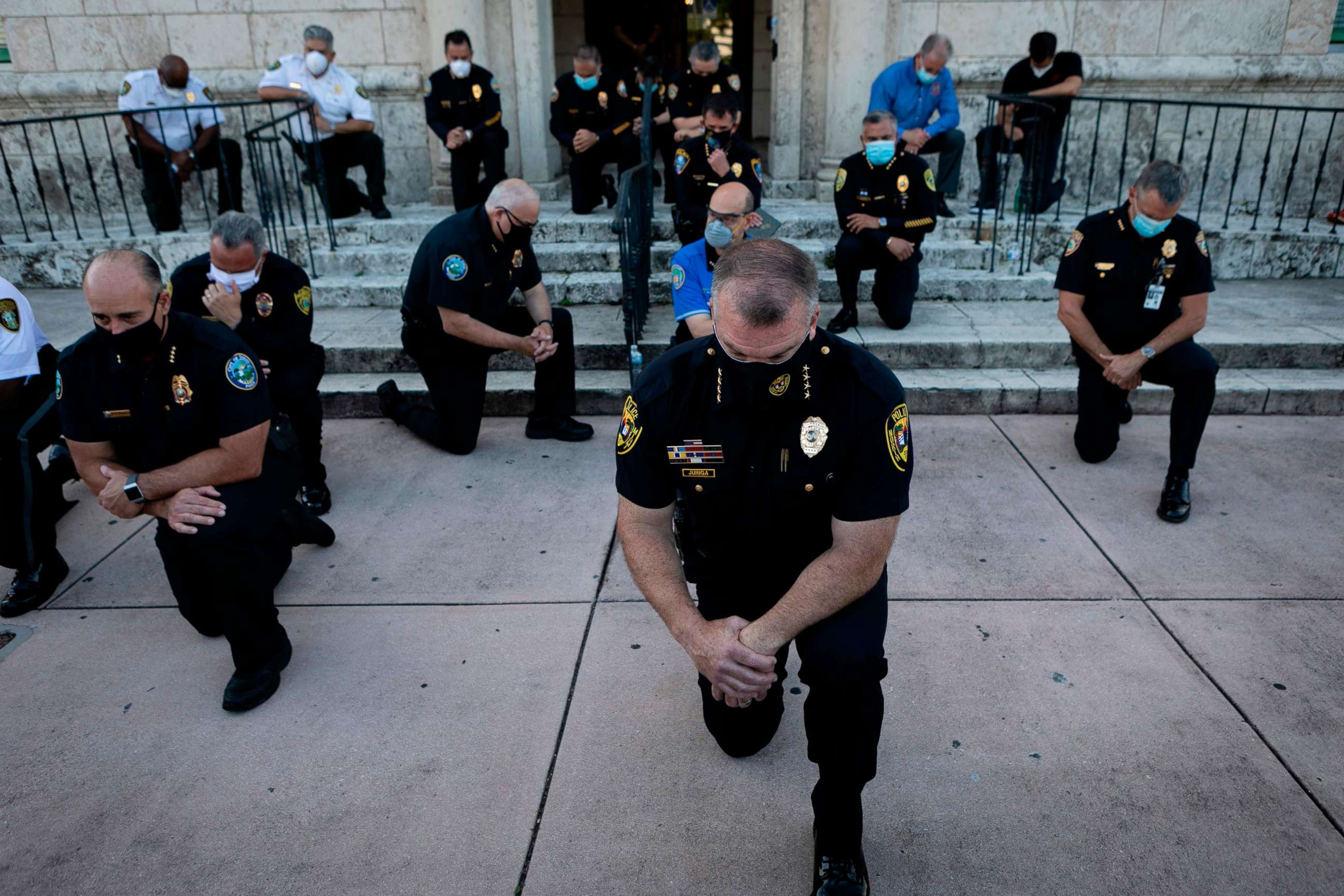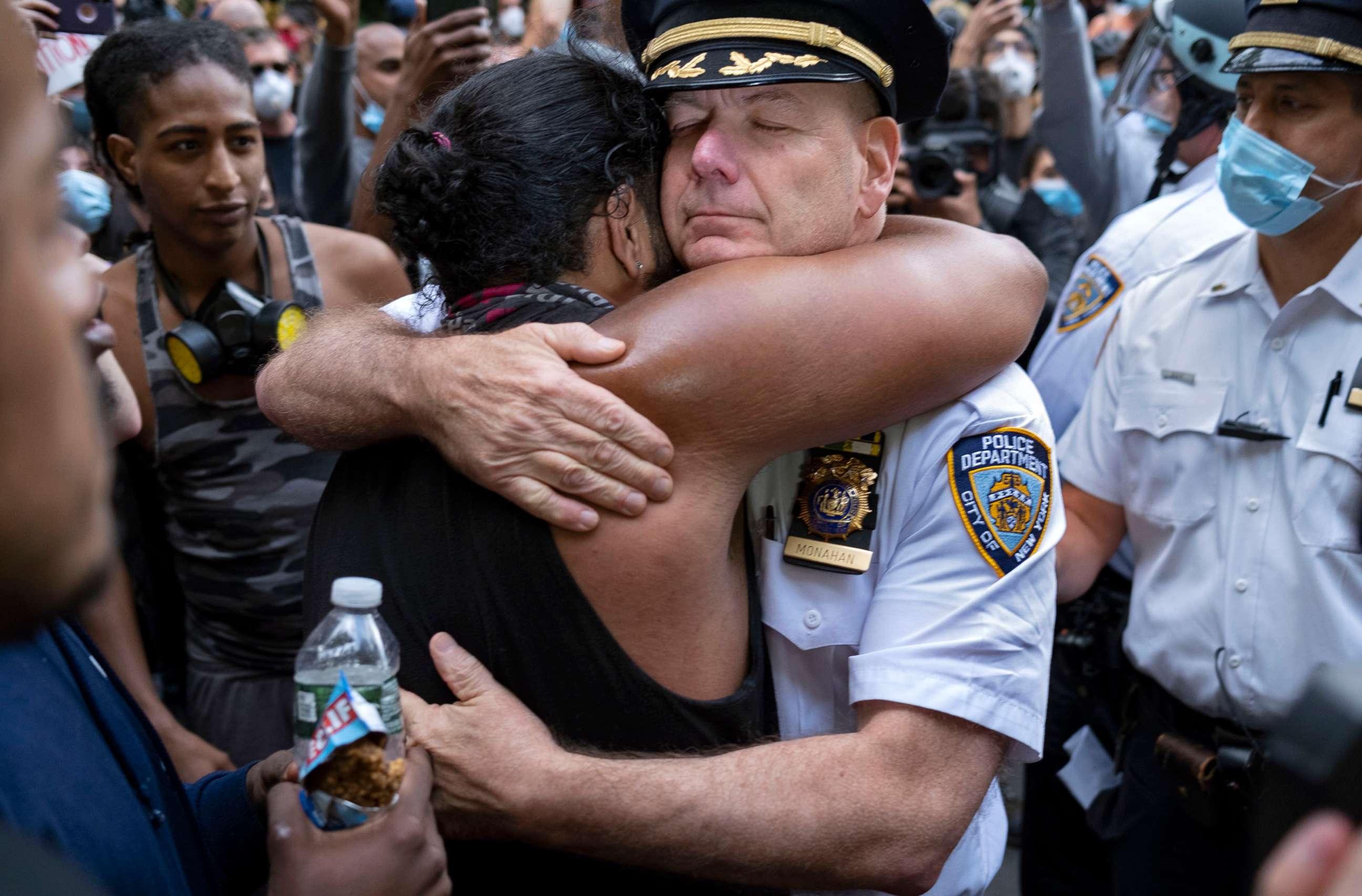Some protesters take issue with police kneeling, calling it 'PR stunt'
Many black organizers say they don't want police kneeling or marching with them.
When a high-ranking Los Angeles Police Department commander kneeled with protesters outside of Mayor Eric Garcetti's house earlier this week, it appeared to be a moment of solidarity. However, many protesters and organizers say they don't want police officers to kneel, with some calling it a "PR stunt" that doesn't contribute to the movement.
While ABC News was interviewing Cory Palka, the assistant commanding officer for LAPD's West Bureau, he was interrupted by Kendrick Sampson, a Black Lives Matter organizer and actor.
"We don't want anybody to take a knee, a knee doesn't help me heal the wounds. They shot me seven times on Saturday," Sampson says, shaking his head. "It does not help my boy who has two broken bones in his skull right now because they aimed a cannon at his head with rubber bullets."
Sampson, who stars on the HBO show "Insecure," called the commander's actions a "farce," and said it was "PR to make them look good."
On Friday, Sampson shared a photo of the bloody wounds on his legs from being shot with pepper balls while also encouraging the mayor to attend a Black Lives Matter town hall.
Similar gestures of police officers kneeling, hugging and marching with protesters around the country have been shared widely on the internet. In many instances, the protesters have been the ones who asked the officers to kneel with them and the gesture has elicited cheers.
The paradox has highlighted the country's struggle to navigate the complex and delicate relationship between law enforcement and the communities they are supposed to protect.
On June 3, Buffalo, New York, police officers were filmed kneeling with protesters outside City Hall. One day later, in a now-viral video, two officers pushed a 75-year-old man to the ground during a protest outside City Hall, seriously injuring him and resulting in both being arrested.
Roxane Gay, a bestselling author and activist, shared the same apprehension as Sampson about protesters sharing moments with law enforcement.
"I need cops and politicians and white people more broadly to stop kneeling," she wrote on Twitter. "We don't need you to kneel. We need you to stand up for real, radical, sustained change."
The specific act of kneeling also carries a different connotation at this particular point in time, as Paula Minor, a Black Lives Matter Los Angeles organizer, pointed out. Given Floyd died with an officer's kneeling on his neck, Minor told ABC News she's "highly uncomfortable" with officers taking a knee.
Minor hopes we don't get caught up in symbolism: "That’s not what we’re here for, the change has to occur from within."
Others, like protester Simeon Bartee, see kind interactions between police officers and protesters as genuine acts of compassion. On Thursday morning, Bartee shared a now-viral video of a white Houston police officer comforting his daughter after she began crying at a protest.
He said he appreciated the sense of comfort the officer gave his daughter.
"I do love that you have those officers who are willing to understand what's going on," Bartee told ABC News. "I know not all officers are racist or prejudiced, not all of them want to harm and antagonize African Americans.
Having experienced police brutality in his own family, Bartee understands the pain the country is going through, adding he would like to see these police officers' empathy extend well beyond the protests.

"It's good to see law enforcement participate with the community and support the community," said Derrick Johnson, president and CEO of the NAACP. However, in order for the country to move on, systemic reform is needed, he added, including the abolishment of qualified immunity and separation of law enforcement from district attorney's offices.
There is no definitive way to judge these interactions as one reality; it depends on the community, Johnson told ABC News. As a Mississippi resident, Johnson said a mile across county lines can mean a much "more hostile environment" for he and his family.
Like many, Johnson has been working to change the fundamental role of law enforcement in our society while threading the needle of police-community relationship.
"If they (police officers) don't live in your jurisdiction, then the connection is different and how they see African Americans is different," Johnson said. "It's hard to respect a community if you're not a part of it."

After a week of nationwide protests sparked by George Floyd's death, the country is showing signs of reformation. Garcetti announced sweeping reforms to the LAPD, including cutting $100 million to $150 million from the department's budget, something protesters have been calling for. Garcetti said $250 million would instead be spent on programs benefitting black and brown communities in the county.
"What would give me hope is if they decide to give us the money, the inflated budget of the police department, and actually put it into systems that were meant to care and stop continuing the legacy of slave catching," Sampson told ABC News.

In addition to budget cuts, the department will invest in implicit bias, training, youth and overnight programs to reduce police misconduct, according to the mayor. The police union was less than supportive of the budget cuts, with the L.A. Police Protective League releasing a statement Friday saying Garcetti had "lost his damn mind."
City leaders in Seattle, San Francisco and Minneapolis are also looking to shift funds from the police department as a means of curbing overly aggressive police tactics. In New York state, the effort to repeal police transparency law is gaining momentum, though facing criticism from police unions.
ABC News' Matt Gutman contributed to this report.




